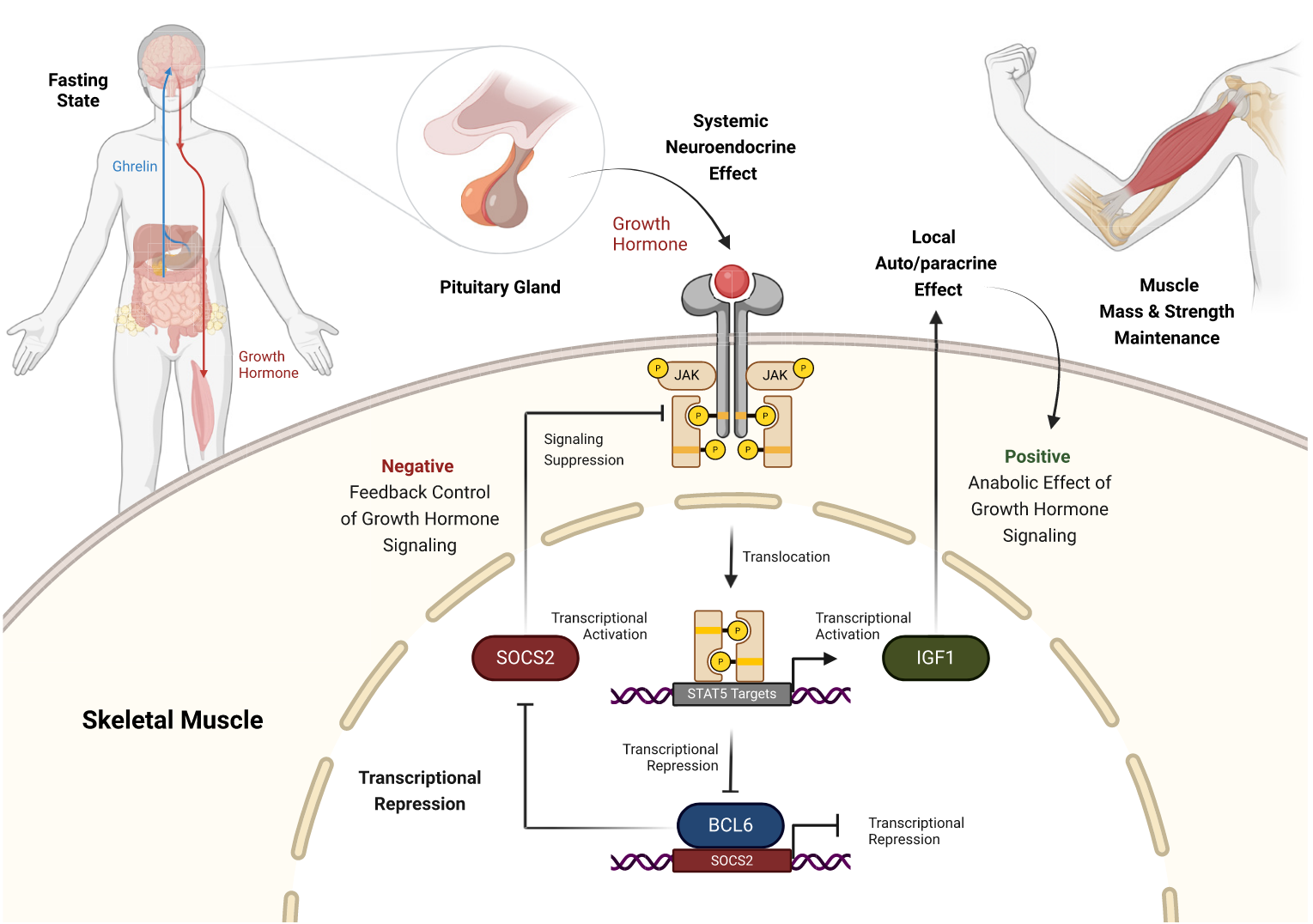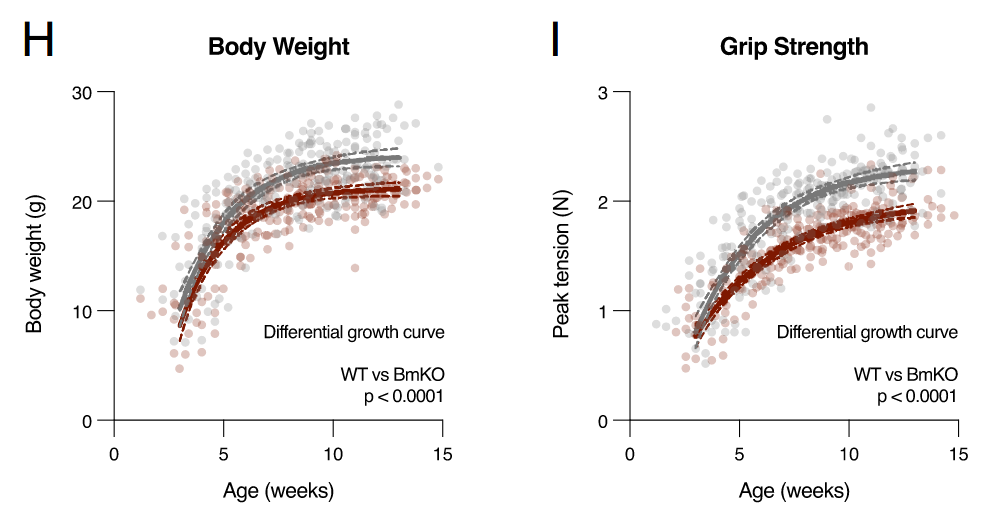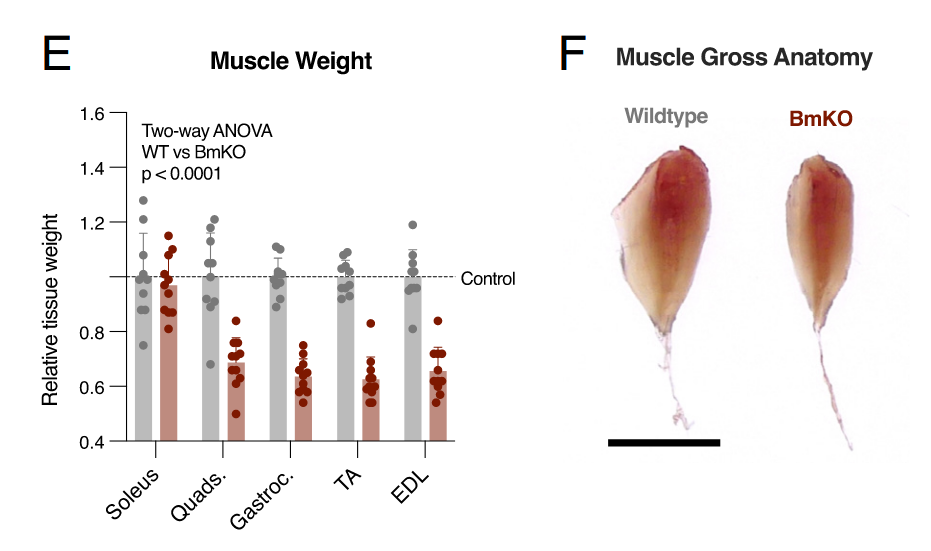Reference
Wang, H. J., Fan, W., Liu, S., Kim, K., Matsushima, A., Ogawa, S., Kang, H. G., Zhu, J., Estepa, G., He, M., Crossley, L., Liddle, C., Kim, M. S., Truitt, M. L., Yu, R. T., Atkins, A. R., Downes, M., & Evans, R. M. (2025). BCL6 coordinates muscle mass homeostasis with nutritional states. Proceedings of the National Academy of Sciences, 122(4), e2408896122. https://doi.org/10.1073/pnas.2408896122
Info
FirstAuthor:: Wang, Hui J.
Author:: Fan, Weiwei
Author:: Liu, Sihao
Author:: Kim, Kyeongkyu
Author:: Matsushima, Ayami
Author:: Ogawa, Satoshi
Author:: Kang, Hyun Gyu
Author:: Zhu, Jonathan
Author:: Estepa, Gabriela
Author:: He, Mingxiao
Author:: Crossley, Lillian
Author:: Liddle, Christopher
Author:: Kim, Minseok S.
Author:: Truitt, Morgan L.
Author:: Yu, Ruth T.
Author:: Atkins, Annette R.
Author:: Downes, Michael
Author:: Evans, Ronald M.
~
Title:: BCL6 coordinates muscle mass homeostasis with nutritional states
Year:: 2025
Citekey:: WangEtAl_2025_BCL6CoordinatesMuscle
itemType:: journalArticle
Journal:: Proceedings of the National Academy of Sciences
Volume:: 122
Issue:: 4
Pages:: e2408896122
DOI:: 10.1073/pnas.2408896122
Link
Abstract
Nutritional status is a determining factor for growth during development and homeostatic maintenance in adulthood. In the context of muscle, growth hormone (GH) coordinates growth with nutritional status; however, the detailed mechanisms remain to be fully elucidated. Here, we show that the transcriptional repressor B cell lymphoma 6 (BCL6) maintains muscle mass by sustaining GH action. Muscle-specific genetic deletion of BCL6 at either perinatal or adult stages profoundly reduces muscle mass and compromises muscle strength. Conversely, muscle-directed viral overexpression of BCL6 significantly reverses the loss of muscle mass and strength. Mechanistically, we show that BCL6 transcriptionally represses the suppressor of cytokine signaling 2 to sustain the anabolic actions of GH in muscle. Additionally, we find that GH itself transcriptionally inhibits BCL6 through the Janus kinase and signal transducer and activator of transcription 5 (JAK/STAT5) pathway. Supporting the physiologic relevance of this feedback regulation, we show the coordinated suppression of muscle Bcl6 expression with the induction of GH in the fasted state. These findings reveal the complexity of the feedback controls modulating GH signaling and identify BCL6 as a key homeostatic regulator coordinating muscle mass with nutrient availability. Moreover, these studies open avenues for targeted therapeutic strategies to combat muscle-wasting conditions.
Blue: Important conclusions
Highlight ( Page )
This finding provides insight into how muscle mass is maintained, especially during periods of fasting. Given the importance of muscle mass in physiological resilience and pathophysiological vulnerability, these findings have the potential to direct therapeutic strategies aimed at preserving muscle mass to afford healthy aging and combat muscle-wasting diseases such as sarcopenia and cachexia.
Highlight ( Page 2)
we identify BCL6 as a key regulatory node of GH actions in muscle, wherein muscle-specific BCL6 knockout mice have reduced muscle mass and impaired strength
Highlight ( Page 2)
implicate BCL6 in maintaining muscle mass and strength by actively controlling protein anabolism in muscle
Highlight ( Page 5)
These results implicate GH and the downstream JAK/STAT pathway in the physiological regulation of muscle BCL6 during fasting (14, 41).
Highlight ( Page 5)
These results suggest that the Socs2 repression by BCL6 is crucial for mediating its effect in sustaining GH action, and lack of which leads to Socs2 derepression and inadequate GH signaling and growth inhibition.
Highlight ( Page 7)
we demonstrate that BCL6 modulates GH signaling via the transcriptional repression of SOCS2, a key negative regulator of GH actions. This negative feedback loop is crucial for maintaining muscle mass, especially in the fasted state, underscoring BCL6 as a homeostatic regulator that coordinates muscle mass with nutrient availability (Fig. 4).
Highlight ( Page 7)
BCL6’s involvement is critical during the fed/fast response, acting as a molecular switch that integrates environmental cues with endogenous growth signaling pathways. This regulatory mechanism ensures that muscle mass is preserved during nutrient scarcity and optimized for energy efficiency and function.
Image ( Page 7)
Yellow: Interesting
Highlight ( Page )
Skeletal muscle comprises approximately 40% of total body mass, representing the largest tissue in the human body (1).
Highlight ( Page )
As a classic regulator of muscle mass, growth hormone (GH) coordinates postnatal development and growth with changes in activity and nutrition status, with GH deficiency resulting in muscle loss (2, 7)
Highlight ( Page )
GH subsequently binds to the growth hormone receptor (GHR) to activate the Janus kinase (JAK)-signal transducer and activator of transcription (STAT) pathway to induce the synthesis of insulin-like growth factor 1 (IGF1) (2, 13, 14). GH-induced IGF1 acts as both an endocrine and auto/paracrine hormone to maintain muscle anabolism (15–17)
Highlight ( Page )
The transcriptional repressor B cell lymphoma 6 (BCL6)
Highlight ( Page 2)
we generated muscle-specific BCL6 knockout (BmKO) mice by crossing the Bcl6-floxed mice (Bcl6fl/fl) with transgenic mice harboring Cre recombinase gene driven by the human alpha-skeletal actin (HSA, ACTA1) promoter (HSA-Cre) (33), and confirmed a nearly complete deletion of the flanked major exons 3 and 4 in muscle (Fig. 1D)
- la perdida de este gen no afecta al musculo? el control es el flox?
Image ( Page 3)
Image ( Page 3)
Image ( Page 4)
Highlight ( Page 5)
The anabolic effects of GH are primarily mediated by the positive effector IGF1 and are tightly regulated by the negative feedback controller SOCS2, both of which are transcriptionally activated by the GH-induced JAK/STAT pathway (13, 20).
Highlight ( Page 5)
BCL6 sustains GH action via direct transcriptional repression of the negative feedback controller Socs2.
Highlight ( Page 5)
GH is essential for maintaining muscle mass and strength during development and in the adult stage (44–47)
Highlight ( Page 5)
To further interrogate the impact of BCL6 modulation on muscle mass and strength in the adult, we utilized a muscle-directed adeno-associated virus to restore Bcl6 expression in BmKO mice
Note ( Page 7)
- Mi intuición: si afectas a este loop, lo más probable es que el problema aparezca por otro lado. Si el cuerpo está enviando señales al músculo para que se degrade y obtener energía, es porque las necesita. Si inhibes que el músculo se degrade, de dónde sale la energía? Quizás los efectos secundarios de un déficit energético sean mucho más peligrosos que simplemente perder un poco de masa muscular mientras tomas semaglutida, que podría compensarse con ejercicio físico.
Green: Agree with the paper
Highlight ( Page 2)
As expected with the myofiber-associated expression pattern of BCL6, tissue weights of the fast-twitch myofiber-enriched EDL, TA, gastrocnemius (Gastroc), and quadriceps (Quads) muscles were reduced by about 40% in adult BmKO mice compared to littermate controls (Bcl6fl/fl HSA-Cre-/- mice) whereas the slow-twitch myofiber-predominant soleus muscle was unaffected
Highlight ( Page 2)
we found significant reduction of AKT activation in BmKO muscle
Highlight ( Page 2)
Functional gene set enrichment analysis of the down-regulated genes in BmKO muscle revealed an enrichment in metabolic pathways (Fig. 1L). In particular, nearly all genes in the glycolysis and fatty acid β-oxidation pathways, as well as mitochondria-encoded OXPHOS complexes were transcriptionally down-regulated in BmKO muscle
Highlight ( Page 2)
We found muscle Bcl6 expression was robustly suppressed by overnight fasting to less than 30% of ad libitumfed controls (Fig. 2A)
Highlight ( Page 2)
interestingly, we found that addition of serum isolated from mice under overnight fasting (16 h) conditions significantly suppressed BCL6 level in vitro (Fig. 2B). These results suggest that the suppressive effect on BCL6 in muscle is predominantly driven by endocrine rather than cellautonomous signaling induced in the fasted state.
Highlight ( Page 2)
BCL6 transcript and protein levels were suppressed by GH (10 ng/mL) treatment which recapitulated the suppressive effect of the fasting serum treatment
Highlight ( Page 5)
selective JAK inhibitors (JAK1: Itacitinib; JAK2: Fedratinib; JAK3: Decernotinib) effectively blocked GH-mediated suppression of BCL6 (Fig. 2E).
Highlight ( Page 5)
In particular, JAK2-selective inhibitor, Fedratinib, completely abolished this suppressive effect of fasting serum on BCL6 levels, suggesting that the well-established GH/JAK2/STAT5 signaling is the key pathway mediating this suppressive effect of BCL6 level in fasting serum
Highlight ( Page 5)
Supporting a role for BCL6 in coordinating GH actions, we observed a nearly 50% reduction in Igf1 expression in TA muscles from ad lib fed BmKO mice, conditions associated with low endogenous GH levels (Fig. 2G).
Highlight ( Page 5)
Tamoxifen treatment (75 mg/kg/day for 5 d, i.p.) suppressed the expression of STAT5 target genes and increased Socs2 expression in 3-mo-old iBmKO mice compared to HSA-MCMnegative littermate controls, largely replicating the constitutive BmKO model
Highlight ( Page 5)
adult deletion of BCL6 results in approximately 40% weight reduction in all fast-twitch myofiberenriched muscles (Fig. 3E) without significantly affecting adipose tissue mass (Fig. 3F). Functionally, these reductions in muscle mass translated into marked and sustained impairments in strength performance over the course of the 4-mo monitoring period compared to tamoxifen-treated littermate controls (Fig. 3 G and H).
Highlight ( Page 5)
A single injection of MyoAAV-mBCL6 (2E+13 vg/kg, s.c.) was able to reexpress BCL6 in all muscle tissues profiled, with minimal expression in nonmuscle tissues except for the liver
Highlight ( Page 7)
MyoAAV-mBCL6 treatment of BmKO mice improved muscle mass compared to vehicle-treated control (Fig. 3M), without impacting food intake and despite an apparent adipose tissue atrophy as expected from viral infection in the liver
Highlight ( Page 7)
SOCS2 as the top BCL6 target gene for direct transcriptional repression in both mouse and human samples. This suppression is integral to the feedback loop regulating STAT5 activity, ensuring that GH signaling is modulated appropriately in response to physiological needs. Such regulation is fundamental to preserving muscle mass and adapting to metabolic demands,
Purple: To learn more
Highlight ( Page 8)
The ability of BCL6 to adapt muscle metabolism and structure in response to varying energy demands suggests that its targeted manipulation could help restore the metabolic flexibility lost in cachectic patients.



